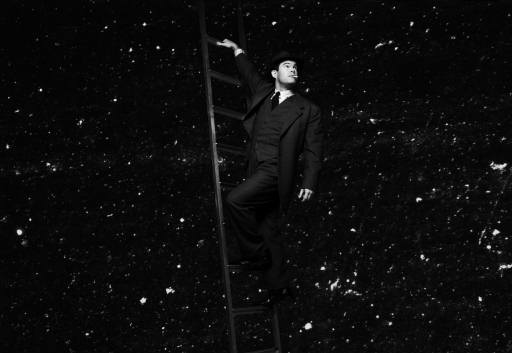Other Links
Editorial Board
- Editor - Bill Kenny
Founder - Len Mullenger
Google Site Search
SEEN
AND HEARD INTERNATIONAL OPERA REVIEW
John Adams, Doctor Atomic: Soloists, Alan Gilbert (conductor), The Metropolitan Opera, New York City, 13.10.2008 and 21.10.2008. (BH)
The Metropolitan Opera
Conductor:
Alan Gilbert
Production:
Penny Woolcock
Set Designer:
Julian Crouch
Costume Designer:
Catherine Zuber
Lighting Designer:
Brian MacDevitt
Choreographer:
Andrew Dawson
Video Design:
Leo Warner & Mark Grimmer for Fifty Nine Productions Ltd.
Sound Designer:
Mark Grey
Edward Teller:
Richard Paul Fink
J. Robert Oppenheimer:
Gerald Finley
Robert Wilson:
Thomas Glenn
Kitty Oppenheimer:
Sasha Cooke
General Leslie Groves:
Eric Owens
Frank Hubbard:
Earle Patriarco
Captain James Nolan:
Roger Honeywell
Pasqualita:
Meredith Arwady

Gerald Finley as Oppenheimer
Somewhere in this well-intentioned study of the nail-biting hours
leading to the test of the first atomic bomb, there is a
transcendent experience that this production did not quite reveal.
And as a fan of John Adams, I was curious enough that I saw it not
once, but twice. With a libretto by Peter Sellars, Doctor Atomic
is perhaps Adams's most ambitious collaboration to date. First
produced by the San Francisco Opera, then in Chicago and
Amsterdam—all three directed by Sellars—this new production at the
Metropolitan Opera was given to Penny Woolcock.
The basic premise is meritorious and worth exploring: getting inside
the head of J. Robert Oppenheimer and his colleagues in Los Alamos,
New Mexico in June of 1945, during those uncomfortable final hours
before the bomb test. The site must have been rife with complex,
conflicting emotions: on one hand, scientific history was about to
be made. On the other, those making it were unleashing a force with
unpredictable consequences.
But the libretto, flickering with possibilities, ultimately kept me
at a safe distance. At least as seen here, the opera seems largely
about "the banality of waiting around." I empathize, but as a
listener I don't feel the need to travel the same journey. And some
scenes seemed hungry for a director's ability to clarify and
amplify—to help focus our attention on what in this story is
important. Often large groups of people are milling about, working
on something related to the impending test, but it is never clear
why, or why we should care.
Given the number of times Doctor Atomic has been produced
already, goodwill is clearly on the creators' side. Much of the
set, by Julian Crouch (whose work was also seen in last season's
Satyagraha) is enticing to look at, such as two massive blocks
of cubicles—three rows of seven on each side—in which singers can
pose, sometimes in gripping images: in the second half, a row of
bodies appear flung to the walls, stuck upside down or at strange
angles. White shades, when drawn, allow animation to be projected:
maps of Japan, equations on a blackboard, and the endless,
relentless rain.
Catherine Zuber's costumes, often in dull browns, effectively
transmit utilitarianism government workers and scientists. These
people were not generally fashionistas, and a sepia-infused
palette seems entirely appropriate. And in further recognition of
teamwork, Brian MacDevitt's lighting often seems inseparable from
Crouch and Zuber's concepts.
Gerald Finley is about as marvelous in the title role as could be
imagined, imbuing Robert Oppenheimer with anxiety and humanity, as
he realizes that the hour of detonation could change the course of
the world forever. Finley has sung the role in San Francisco and
Chicago, and should probably consider adding "Batter My Heart," a
setting of John Donne's poem, to his recitals. As his wife, Kitty,
Sasha Cooke sounds lustrous. Adams gives her lilting arioso-style
lines, and her timbre is welcome in a sea of tenors and basses. Yet
some key personality traits were under-emphasized, such as her
alcoholism; one friend felt the part could have been excised
altogether.
As General Leslie Groves (and in his Met debut), Eric Owens displays
a powerful voice, as does Richard Paul Fink as Edward Teller. Both
have distinctive solos. But as the Groves character lists the
high-calorie foods he ate as a child, I found myself mentally
squirming, wishing that there were more light on other anxieties.
Is that really what he was thinking during these restless hours?
In smaller roles, Thomas Glenn, Earle Patriarco and Roger Honeywell
all do fine work. Also in her Met debut, Meredith Arwady brings a
rich alto to the role of Pasqualita, Kitty's Indian maid. But any
meaning allotted to her character evaporates when a row of silent
Indians materializes, since it's never quite clear why they do so.
Throughout all of this, Adams's music shimmers and growls. Brass
often dominate the mix, and some delicious bassoon squalls underline
the evening's anxiety. The orchestra is often highly effective
melded with electronic sounds. Although often pegged as a
minimalist, Adams finds a romantic streak to inform Oppenheimer's
meditations: his big John Donne aria that ends Act I almost brings
down the house. (With a different spin on the scene, it would
probably provoke cheers.) And there are some marvelous thundering
scenes for the terrific Met Chorus, whose sound seems fuller and
fuller with each production under the direction of Donald Palumbo.
During the final minute or so, taped voices of Japanese bomb
survivors can be heard, asking for water, and in another universe
such pleas should be overwhelmingly touching; friends who have seen
the intimacy of the opera on DVD said they had tears in their eyes.
But here, I felt that the emotions evoked weren't entirely earned,
and didn't summon up the horror and sorrow that I suspect the
opera's creators intended. I'm afraid my chief reaction was just
wanting to go home.
Photo: © 2008 Nick Heavican
Back
to Top
Cumulative Index Page
